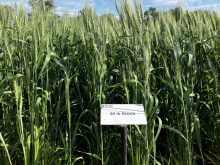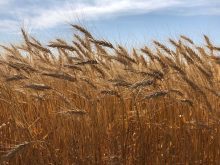Soil fertility for field crops is a very simple affair but extremely difficult to easily explain. Think logically. There are no miracle fertilizers, only plain and simple chemical nutrients whether from an organic source or from a concentrate of nutrients we call chemical or synthetic fertilizer.
There is no such thing as a synthetic fertilizer. Every ounce/gram of fertilizer you buy came from a natural source and was concentrated for ease of use. All of the chemical phosphate (P) or sulphur (S) we use, for example, came originally from organic deposits on this earth.
Nitrogen (N), considered the key element (it’s 80 per cent of the air we breath), can be fixed or manufactured using heat and pressure, a very costly process, and made into fixed or plant-usable nitrogen. This nitrogen is the same as that fixed by legumes or the nitrogen that is fixed by lightning strikes during a thunderstorm.
Read Also

Claas brings 1000 Series SP forage harvesters to Canada
In mid-August, Claas unveiled its new line of Jaguar forage harvesters at an event in Visalia, California, deep in the heart of that state’s dairy region.
Plant nutrients are simply divided into macronutrients, such as nitrogen, phosphorus, potassium, sulphur, magnesium and calcium, or micronutrients, such as boron, iron, copper, zinc and molybdenum.
All plant nutrients, whether from organic or “chemical” sources are the same. All plant nutrients must be soluble in water to enter the plant root system. Macronutrients such as oxygen, hydrogen and carbon come from air and water.
In typical Prairie soils, following repeated crop removal, or hay or grass pasture by livestock, the nitrogen, phosphorus, potassium and sulphur as well as the micronutrients can become depleted and crop or livestock limiting.
There is no difference in the amount of macro and micronutrients needed to give you a 60-bushel wheat crop, whether from “chemical” fertilizers or from organic sources such as livestock manures or other sources.
When the Canadian Prairies were first farmed several hundred years ago, they were considered for the most part fertile, since they had evolved as grasslands for more than 10,000 years with no removal of nutrients. Recyclable grazing by livestock such as bison, cervids and other grass- (forage-) eating wildlife, merely circulated the natural nutrient buildup, including their bodies when they died or were eaten by carnivores.
A 60-bushel wheat crop removes from the soil the approximate nutrient amounts listed in Table 1 (below). If the grain itself is removed, then those macro and micronutrients are taken from the soil nutrient bank.

At present-day prices, the straw nutrients when added up would cost around $120 or more per acre to replace. This does not include the cost of baling and transport.
I have written several articles on straw removal in previous issues of Grainews. In one such article, I gave 16 reasons why you should, as a farmer, never sell a bale of straw. I can now cite 20 reasons why you should never sell straw except, perhaps, in rare instances.
In a recent check of straw bale prices in 2022, I saw 500-pound bales listed at $11 and 800-pound bales at $20 to $25. These farmers need straw choppers or, perhaps, at the sale prices they sell the straw, they could apply for charitable status.
When you work your chopped, or otherwise, crop residues back into your cropland, you are maintaining your soil organic matter or, at the very least, reducing its loss. This black humus or soil organic matter varied a few hundred years ago from two to three per cent to as high as 12 per cent on the unfarmed Prairies. This black humus (humic and fulvic acids and a lot more complex nutrients) is the very heart of the Prairie cropland’s nutrient storage.
A two per cent organic soil typical of the original drier prairie contains about 21,000 pounds of carbon, 2,000 pounds of nitrogen, 200 pounds of sulphur and a pound or so of boron as well as a few hundred pounds of organic phosphates. Potash (potassium), like calcium and magnesium minerals, are held in or are part of the microscopic or visible soil particles.
To put things in perspective, one acre of cropland soil to a depth of six inches is generally around two million pounds (0.405 hectares at a depth of 15.24 centimetres weighs 907,184 kilograms). Thus, if you add two pounds of actual boron (B) in the form of sodium borate, you will end up on one acre of soil with a boron level of one part per million (1 ppm). Remember, sodium borate is only 21 per cent actual boron, so to achieve this level of one part per million of boron in an acre of cropland you need to add about 10 pounds of sodium borate.
When the Prairies were first cultivated, only a few hundred years ago, little or no fertilizer was added to this cropland. The nutrients for the crops, primarily small grain cereals, came from the soil organic matter for nitrogen, phosphate and sulphur, and the soil mix (silt, sand and clay) provided the potassium, calcium and magnesium and the micronutrients.
In soil areas with five to 10 per cent organic matter, nitrogen and other nutrients released from the organic matter and the soil generally resulted in wheat crops of 30 to 40 bushels per acre. A five per cent organic matter soil would release perhaps 50 pounds of nitrogen and a 10 per cent organic matter soil perhaps 100 pounds or more. These Prairie soils had enough phosphorus, potassium, calcium and magnesium as well as micronutrients to meet the 30- to 40-bushel wheat crop of years ago when the Prairies were first farmed.
Unfortunately, after 100 to 200 years of cropping and fallowing, those two to three per cent organic soils became one and 1.5 per cent and 10 per cent organic soils were lowered to five to six per cent. The annual nitrogen yield from these organic soils dropped to 50 per cent or less and phosphate and sulphur levels plunged down to crop deficiency levels.
By the 1970s and ’80s, wheat yields were in the low twenties on the Canadian Prairies and barley in the 40-plus range. To raise crop production levels, growers had to drastically up the nitrogen, phosphorus, sulphur and, in some instances, the potassium levels. This was needed to bring the average wheat yields per acre at that time into the low fifties.
It could be said that up to the 1940s or even the ’50s, the Prairies were organically farmed with every second year allowing wheat or other grain cropland to fallow for weed control, resulting in a boost in the fallow year from released nutrients from the organic fraction of the soil.
The Prairie soils were being drained of macronutrients in particular and in many instances micronutrients like zinc and copper. In soils greater than pH 5.5, magnesium and calcium deficiency are normally present in such quantities to not become a nutrient deficiency problem.
It can be said that from the first time that the Prairies were cultivated, the system could be fully labelled as “organic farming.” It was this organic farming up to the 1950s that led to the present deterioration of the Prairie cropland as we know it today. Present-day conventional farming, by adding needed crop nutrients and returning the crop residue, results in much improved soils and a doubling or even tripling of crop yields.
I am certainly not against “organic farming,” if that’s what some people want, but if you hope to obtain substantial crop yields you have to put in the required nutrients in the form of livestock manure or approved organic fertilizers. In addition, organic growers often fallow their cropland to control weeds, a procedure that facilitates wind and water erosion as opposed to the present no-till methodology.
Thus, to meet a target yield for a given area of the Prairies, growers, whether conventional or organic, must provide the necessary nutrients, which are readily taken up by the specific crop, if they expect yields from 40 to 100 bushels of wheat per acre. There are no miracles in crop production, just sound scientific facts. You need inputs to obtain outputs in terms of crop yields.
















